|
Lhasa |
|
Lhasa the traditional capital of Tibet
and the capital of the Tibet Autonomous Region is the largest
city in Tibet with an area of 544 square kilometers. Lhasa is
the center of Tibet's political, economic, cultural and
religious activities. Lhasa literally means "The Place of
Gods". It is situated at the foot of Mount Gephel, on the
north bank of River Lhasa, a tributary of the Yarlung Tsangbo
River, at an altitude of 3,700 meters and counts among the one
of the highest cities in the world. With more than 3,000
hours of sunshine annually, Lhasa is famed as "the City of
Sunshine" also. There are many historic sites and famous
relics in the city proper and its suburbs, among which the
Potala Palace, Jokhang Temple, Drepung Monastery, Sera
Monastery and Gandan Monastery are world famous. The city is
the traditional seat of the Dalai Lama and the Potala and
Norbulingka palaces and in Tibetan Buddhism is regarded as the
holiest centre in Tibet. Lhasa enjoys mild weather and is free
of both frigid winters and unbearably hot summers. It rains
mainly in July, August and September. The rainy seasons in the
summer and fall are widely regarded the "best" seasons of the
year, during these seasons it rains mostly at night and days
are bright and sunny. |
 |
|
| |
|
History |
|
Lhasa has long interesting history.
Before the mid-seventh century when Lhasa was yet to come into
being, the area was known as Wotang. It was a marshy land of
wildness, frequented by antelopes. On one bright summer day,
Songtsan Gampo, leader of the Tubo tribe that had risen to
power in the Yarlung River Valley, was struck by the perilous
position of an area flanked by two steep mountains, while
bathing in the Lhasa River, and decided that this was to be
the home of his kingdom. This ambitious Tibetan king moved the
center of his rule to Wotang and ordered the construction of
his residence on the hilltop of Potala. In 641 A.D., Songtsan
Gampo who by this time had conquered the whole Tibetan region
wedded Princess Wencheng of the Imperial Tang Court. When the
princess arrived, she became convinced that Lake Wotang was a
devil's heart to be overpowered by the construction of a grand
temple after filling up the lake with earth. The princess
further suggested that the earth be carried by white goats.
This imposing grand temple became a symbol of the kingdom. The
temple, later known as Jokhang, was initially named Lhasa,
"the Sacred Land" in Tibetan. Over the centuries, Lhasa became
a political and religious center of Tibet. Administrative
orders were issued from the myriad of imposing palaces. The
great temples and monasteries were home to invincible
liturgical establishment and witnessed the rise of many
religious leaders and endless religious ceremonies. The
faithful composed the population of the town and Lhasa became
a true "Mecca" of Tibet. |
|
| |
|
Major Tourist Attractions |
|
Lhasa has many historic sites and famous
relics in the city proper and its suburbs, among which the
Potala Palace, Jokhang Temple, Drepung Monastery, Sera
Monastery and Norbulingka Palaces are world-renowned. |
|
| |
|
Jokhang Temple |
 |
This temple is
one of the most sacred and important temples in Tibet. A
part of the UNESCO World Heritage Site "Historic Ensemble
of the Potala Palace" and a spiritual centre of Lhasa, it
is perhaps the most popular tourist attraction in Lhasa.
It was built by King Songtsän Gampo probably in 642. It
was originally called the Rasa Tulnang Tsuklakang or 'The
House of Mysteries, The Magical Emanation at Rasa. Both
Bhrituti and Wencheng, the Nepalese and Chinese wives of
Songsten Gampo brought important Buddhist images to Tibet
as part of |
|
their dowries,
which are housed here. The famous Buddhist Master, Atisha,
taught here in the 11th century and it has been considered
the most important temple in Lhasa ever since. This temple
has remained a key center of Buddhist pilgrimage for
centuries. It was sacked several times by the Mongols, but
the building survived. In the past several centuries the
temple complex was expanded and now covers an area of
about 25,000 sq. meters. |
| |
|
The
Jokhang temple is a four-storey building, with roofs
covered with gilded bronze tiles. Originally it was
constructed on the bases of Indian vihara design, and
was later extended resulting in a blend of Nepalese
and Tang Dynasty styles. The rooftop statues of two
golden deer flanking a Dharma wheel is iconic. The
Jokhang temple complex has several decorated shrines
and rooms. The main hall of the temple has the Jowo
Shakyamuni Buddha statue, which is perhaps the single
most venerated object in Tibetan Buddhism. It also
hoseas famous statues of Chenresig, Padmasambhava and
King Songtsan Gambo and his two famous foreign brides,
Princess Wen Cheng of China and Princess Bhrikuti of
Nepal. Many of the statues were destroyed during the
"cultural revolution" but have since been remade -
often including broken pieces of the original statues. |
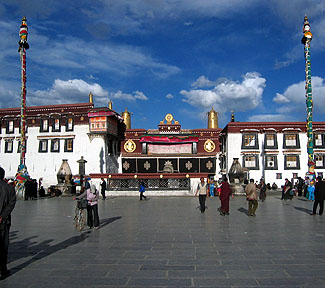 |
|
|
|
| |
|
Sera Monastery |
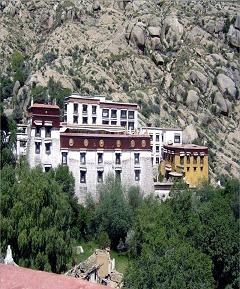 |
'Sera
literally means 'Enclosure of Roses', is one of the 'great
three' Gelukpa university monasteries of Tibet. The other
two are Ganden Monastery and Drepung Monastery. The
monastery is about 5 km north of the Jokang in Lhasa. It
was founded in 1419, by Jamchen Chojey (Sakya Yeshe), a
disciple of Tsong Khapa. Like the Drepung and Ganden
monasteries, it had three colleges, namely Sera Mey
Dratsang, Sera Jey Dratsang, and Ngagpa Dratsang. Sera Mey
Dratsang was built in 1419 and used to give basic
instruction to the monks, the largest college, Sera Jey
Dratsang was constructed in 1435, and was reserved for
wandering monks, especially Mongol monks. Ngagpa Dratsang,
built in 1559, was a school for the teaching of the
Gelukpa tantras. In 1959, Sera housed more than 5,000
monks. Although badly damaged, it is still standing and
has been largely refurbished. It now houses a few hundred
Buddhist monks. The Sera’s library houses some of the
valuable prayer books. Prayers books in Sera's library
Graduates of Sera Jey College who are known in the west
include, Lama Thubten Yeshe, Geshe Kelsang Gyatso, Lama
Thubten |
|
Zopa Rinpoche.
Graduates of Sera Mey college who are known in the west
include, Pabongka Rinpoche—Author of Liberation in the
Palm of Your Hands, Kyabje Trijang Rinpoche—one of the
current Dalai Lama's teachers, Sermey Khensur Rinpoche
Geshe Lobsang Tharchin—former abbot of Sera Mey university
in Bylakuppe. |
|
|
| |
|
Drepung Monastery |
|
Literally
means the 'Rice Heap' monastery', Drepung is also one of
the "great three" Gelukpa university monasteries of Tibet.
Drepung is the largest of all Tibetan monasteries, and
indeed at its peak was the largest monastery of any
religion in the world. Jamyang Chojey, who was a direct
disciple of Je Tsongkhapa, the founder of the Gelukpa
school, founded it in 1416. It is located on the Gambo
Utse mountain, 5 kilometers from the western suburb of
Lhasa.
At its
largest, before the Chinese invasion of Tibet in 1959, the
monastery housed fifteen thousand celibate monks and was
known |
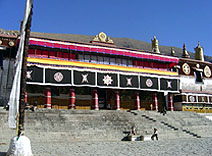 |
|
for the high
standards of its academic study. Young monks of Drepung is
divided into what are known as the seven great colleges -
Gomang, Loseling, Deyang, Shagkor, Gyelwa or Tosamling,
Dulwa, and Ngagpa. Routines in Drepung monastery is
comprised of four parts: education, religious rites,
education administration and sundry affairs. It can be a
somewhat useful analogy to think of Drepung as a
university along the lines of Oxford or the Sorbonne in
the middle ages, the various colleges having different
emphases, teaching lineages, or traditional geographical
affiliations. Today the population at the monastery is
much smaller with merely a few hundred monks, due to
population capping enforced by the Chinese government.
|
|
|
| |
|
Norbulingka Palace |
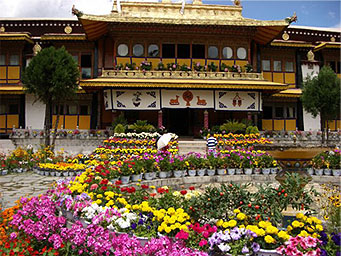 |
Norbulingka
literally means "The Jewelled Park" or the “Treasure
Park”. It is a palace and surrounding park, which served
as the traditional summer residence of the successive
Dalai Lamas from the 1780s up until the PRC takeover in
the late 1950s. It was first built in the forties of the
eighteenth century, covering a space of 40 hectares after
continuous expansion by the Dalai Lamas. The earliest
building is the Gesang Pozhang Palace built by Kelzang
Gyatso. Khamsum Zilnon is another eye-catching building
behind the main gate. It was originally a Han style
pavilion and later changed into a theater where the Dalai
Lamas watched Tibetan opera. Tsokyil Potrang is a group of
buildings on water. |
| |
|
Dalai Lamas
used to read in a
hall of the palace. Construction seldom stopped under the
reigns of different Dalai Lamas. In 1922, the Thirteenth
Dalai Lama began to build his Golden Lingka and Chensel
Potrang, which is located at the back of the woods. The
palace was heavily painted with murals, which bear strong
Han characteristics. In 1956, the Fourteenth Dalai Lama
finished his own palace - Takten Migyur Potrang, usually
called New Summer Palace. Though it is called New Summer
Palace, it is a very traditional architecture except for
its interior modern facilities. In the palace there are
many splendid murals painted by a Fourteenth Dalai Lama's
painter. The topics of the murals include Tibetan
officials, Sakyamuni preaching under a Bodhi tree, and
Tibetan history from its founding by the Holy Monkey, the
vicissitudes of Tubo Kingdom (633-844) and Tibetan
Buddhism to Panchen Lama and Dalai Lama's interviews with
Chairman Mao Zedong in Beijing.
This palace
holds beautiful gardens that are favorite picnic spots and
provide a beautiful venue for theatre, dancing and
festivals, particularly the Sho Dun or 'Yoghurt Festival'.
It is celebrated at the beginning of August, with families
camping in the grounds for days surrounded by colourful
makeshift windbreaks of rugs and scarves and enjoying the
height of summer weather. There is also a zoo at
Norbulingka, originally to keep the animals which were
given to the Dalai Lama. Heinrich Harrer helped the 14th
Dalai Lama build a small movie theatre there in the
1950s.
In 2001,
UNESCO inscribed Norbulingka on its World Heritage List as
part of the "Historic Ensemble of the Potala Palace".
|
|
|
|
|
The Potala Palace |
|
Named after
Mount Potala, the abode of Chenresig or Avalokitesvara, it
is one of the most popular tourist sites in Lhasa. Potala
palace is located at an altitude of 3,700 m, on the side
of Marpo Ri hill, the Red Mountain in the center of Lhasa
Valley. It was the chief residence of the Dalai Lama until
the 14th Dalai Lama fled to Dharamsala, India after a
failed uprising in 1959. Today the Potala Palace is a
state museum of China. The first palace was built by King
Songtsen Gampo in 637 in order to greet his bride Princess
Wen Cheng of the Tang Dynasty of China. The construction
of thepresent palace began in 1645 under the fifth Dalai
Lama, Lozang Gyatso. In 1648, the Potrang Karpo
known as White Palace was completed, and the Potala became
the winter palace of Dalai Lama from that time. |
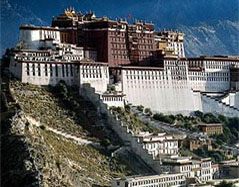 |
|
The Potrang Marpo or the Red
Palace was added to the complex between 1690 and 1694. It
was inscribed to the UNESCO World Heritage List in 1994
and was named as the "New Seven Wonders" by American
media. |
|
|
| |
|
Famous Buildings
in Potala Palace |
| |
|
White Palace |
|
 |
The White Palace is the part of the Potala Palace that makes
up the living quarters of the Dalai Lama. The first White
Palace was built during the lifetime of the fifth Dalai Lama
in the 1650s then was extended to its size today by the
thirteenth Dalai Lama in the early twentieth century. The
palace was for secular uses and contained the living quarters,
offices, the seminary and the printing house. A central,
yellow-painted courtyard known as a Deyangshar separates the
living quarters of the Lama and his monks with the Red Palace.
The yellow building at the side of the White Palace in the
courtyard between the main palaces houses giant banners
embroidered with holy symbols which hung across the south face
of the Potala during New Year festivals. |
|
| |
|
Red Palace |
|
The Red Palace is part of the Potala
palace that is completely devoted to religious study and
Buddhist prayer. It consists of an intricate layout of many
different halls, chapels and libraries on many different
levels with a multifaceted array of smaller galleries and
winding passages:
|
|
| |
|
The Great West Hall |
|
The great West Hall is the main central
hall of the Red Palace, which consists of four great chapels
that proclaim the glory, and power of the builder of the
Potala, the Fifth Dalai Lama. The hall is illustrious for its
fine murals reminiscent of Persian miniatures, depicting
events in the fifth Dalai Lama's life. The famous scene of his
visit to Emperor Shun Zhi in Beijing is located on the east
wall outside the entrance. The numerous columns and pillars of
the hall are wrapped with a special cloth from Bhutan.
|
|
| |
|
The Saint's Chapel |
|
On the north side of the great west hall
is this holiest shrine of the Potala. The 19th century Tongzhi
Emperor of China wrote a large blue and gold inscription over
the door. It contains a small ancient jewel encrusted statue
of Avalokiteshvara and two of his attendants. On the floor
below, a low, dark passage leads into the Dharma Cave where
Songsten Gampo is believed to have studied Buddhism. In the
holy cave are images of Songsten Gampo, his wives, his chief
minister and Sambhota, the scholar who developed Tibetan
writing in the company of his many divinities. |
|
| |
|
The North Chapel |
|
The North Chapel centres on a crowned
Sakyamuni Buddha on the left and the Fifth Dalai Lama on the
right seated on splendid gold thrones. Their equal height and
shared aura entails an equal status. On the far left of the
chapel is the gold stupa. This tomb belongs to the Eleventh
Dalai Lama who died as a child and has rows of benign Medicine
Buddhas who were the heavenly healers. On the right of the
chapel are Avalokiteshvara and his historical incarnations
including Songsten Gampo and the first four Dalai Lamas.
|
|
| |
|
The South Chapel |
|
The South Chapel centres on
Padmasambhava, the 8th century Indian magician and saint
accompanied by his two wives. His Tibetan wife, a gift from
the King is by his left knee and his other wife from his
native land of Swat is by his right. On his left, eight of his
holy manifestations meditate with an unturned gaze. On his
right, eight furious manifestations wield instruments of magic
powers to subdue the demons of the Bon faith.
|
|
| |
|
The East Chapel |
|
The East chapel is devoted to Tsong
Khapa the founder of the Gelug tradition. Lamas from Sakya
Monastery who had briefly ruled Tibet and formed their own
tradition until converted by Tsong Khapa surround his central
figure. There are also some other statues on display that are
made of various different materials and exhibit noble
expressions. |
|
| |
|
The West Chapel |
|
This chapel contains the five golden
stupas. The massive central stupa contains the mummified body
of the Fifth Dalai Lama. This stupa is built of sandalwood and
is amazingly coated in 3,727 kg of solid gold and studded with
semi-precious jewels. It is almost 50 feet high and rises to
three storeys. On the left is the funeral stupa for the
Twelfth Dalai Lama and on the right that of the Tenth Dalai
Lama.
|
|
| |
|
The Galleries |
|
The First Gallery is on the floor above
the West chapel and has a number of large windows that give
light and ventilation to the Great West Hall and its chapels
below. The Second Gallery provides access to the central
pavilion which is used for visitors to the palace for
refreshments and to buy souvenirs. The Third Gallery has a
number of dark rooms branching off it containing enormous
collections of bronze statues and miniature figures made of
copper and gold worth a fortune.
|
|
| |
|
The Tomb of the Thirteenth Dalai Lama |
|
The tomb of the 13th Dalai Lama is
located west of the Great West Hall. Built in 1933, this 14
metres high giant stupa holds priceless jewels and one ton of
solid gold. Devotional offerings include elephant tusks from
India, ceramic lions and vases and a pagoda made from over
200,000 pearls. The elaborated murals of stupa exhibit the
traditional Tibetan style and depict many events of the life
of the Thirteenth Dalai Lama during the early 20th century. |
|
|
|
|
The Barkhor Street
|
|
The circular Barkhor Street is the
oldest street of old Lhasa city. Found in the heart of Lhasa
and circling the Jokhang Temple it is the trading as well as
religious center of the city. It means 'a pilgrim's inner
circuit'. It dates back to the foundation of the Jokhang
Temple and is an essential pilgrim route. Buddhist pilgrims
walk or progress by body-lengths along the street clockwise
every day into deep night to reach Jokhang temple. This sacred
pilgrim path, is also a marketplace where shaggy nomads,
traders, robed monks and chanting pilgrims join together. It
is also called 'the window of Tibet' as it typically reflects
the Tibetan life and culture. Religious objects such as prayer
flags, prayer wheels, thangkas (a kind of mounted scroll
paintings ), sutras, prayer beads, etc. as well as jewelry,
Tibetan knives, food, costume, and so on are easily found in
this ancient street. The street also has other facilities like
inns, restaurants, cafes, etc. that serve locals as well as
tourists. A blend of Tibetan culture, economy, religion and
arts this street combines ancient and modern, religious and
everyday life in perfect harmony and is a must-see for all
visitors! |
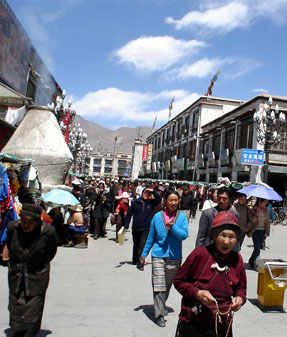 |
|
| |
|
|

